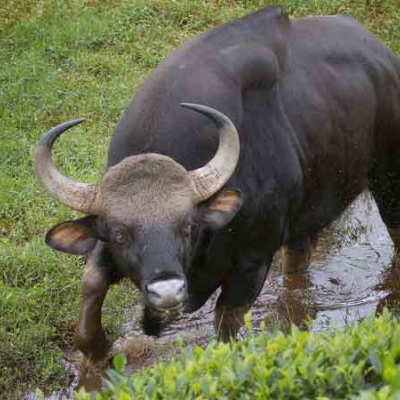Kanyakumari is a beautiful city located at the tip of Indian sub-continent. This lovely land is bordered by Kerala on the North West, Tirunelveli District in north-east, Arabian Sea in the south-west, Bay of Bengal in the South east and Indian Ocean in the south.

The verdant forests of Kanyakumari came into existence in the year April 1st 1977 in an area of 50486 ha, which is equal to 30.2% of the total geographic area of the Kanyakumari District.
The forest has many peaks, few notable ones are Mahendragiri (1645.2 m) in Mahendragiri RF, Mottaichi peak (1590.4 m) and Varaittumudi (1426.2 m).
FLORA
The forests of this Division constitute the southern tip of the Western Ghats forests. Various types of Forests from luxuriant Tropical Wet Evergreen forests to Southern Thorn Scrub forests occur in this division because of diverse locality factors (edaphic and biotic) varying rainfall from 50 to 310 cm and elevations from Sea level upto 1829 M.
The forest area includes all kinds of forests including Southern Hilltop Tropical Evergreen Forests, West Coast Tropical Evergreen Forests, West Coast Semi Evergreen Forests, Moist Teak Forests, Slightly Moist Teak Forests, Southern Moist Mixed Deciduous Forests, Dry Teak Forests, Southern Dry Mixed Deciduous Forests, Dry Savannah Forests Carnatic Umbrella thorn forests, Southern Thorn Forests, Southern Thorn Scrub, Southern Sub-tropical Hill Forests, Hill top Grassland and Ochlandra Reed Brakes
Rare flora:
In the Red Data Book, the Botanical survey of India had categorized the present status of 427 Indian plants. Out of this, 123 species occur in Tamil Nadu, and as many as 62 species are endemic to Tamil Nadu. 39 of these occur in the Western Ghats.
FAUNA
This forest gives protection to many fauna. Few important among them are Bonnet Macaque, Common Langur or Hanuman Langur, Nilgiri Langur, Slender Loris, Tiger, Leopard or Panther, Jungle Cat, Small Indian Civet, Mongoose, Jackal, Indian Fox, Dhole or Indian Wild Dog, Sloth Bear, Otter, Large Brown Flying Squirrel, Flying Fox, Indian Giant Squirrel, Indian Porcupine, India Hare, Indian Elephant, Gaur or India Bison, Nilgiri Tahr, Chital or spotted Deer, Black Buck or Indian Antelope, Sambar, Barking Deer, Mousse Deer or India Chevrotain, Wild Boar and Pangolin
Travel:
Kanyakumari is a famous tourist destination in Tamilnadu, hence lots of busses, trains ply from all major cities of TN.
How to reach:
By Air: Trivandrum International Airport (TRV), located about 90 kilometres from Kanyakumari, where you can then hire a cab or other local transportation to reach the location.
By Train: Kanyakumari Railway Station is one of the main train stations; you can take a local bus or hire a taxi to get to the sanctuary.
By Road: You can hire an auto rickshaw or take a local bus to reach the location.
FAQ:
1.What is the best time to visit Kanyakumari Wildlife Sanctuary?
October through March are the finest months to visit the sanctuary. It's perfect for outdoor activities and animal viewing throughout these months because of the excellent weather.
2.Are there any trekking or hiking opportunities in the sanctuary?
Yes, there are several trekking and hiking trails in the sanctuary.
3.Are guided tours available?
Sure, for a deeper understanding of the sanctuary's flora and fauna, guided excursions are offered and highly recommended.